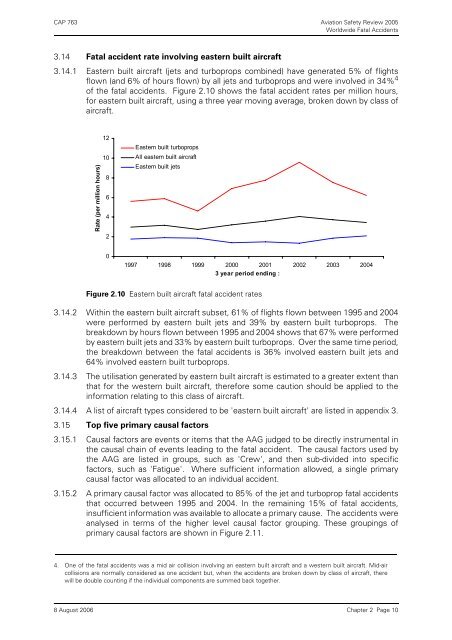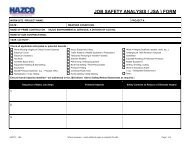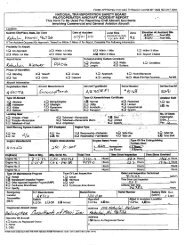CAP 763
CAP 763 Aviation Safety Review - Contact Us
CAP 763 Aviation Safety Review - Contact Us
- No tags were found...
You also want an ePaper? Increase the reach of your titles
YUMPU automatically turns print PDFs into web optimized ePapers that Google loves.
<strong>CAP</strong> <strong>763</strong> Aviation Safety Review 2005<br />
Worldwide Fatal Accidents<br />
3.14 Fatal accident rate involving eastern built aircraft<br />
3.14.1 Eastern built aircraft (jets and turboprops combined) have generated 5% of flights<br />
flown (and 6% of hours flown) by all jets and turboprops and were involved in 34% 4<br />
of the fatal accidents. Figure 2.10 shows the fatal accident rates per million hours,<br />
for eastern built aircraft, using a three year moving average, broken down by class of<br />
aircraft.<br />
Rate (per million hours)<br />
12<br />
10<br />
8<br />
6<br />
4<br />
2<br />
Eastern built turboprops<br />
All eastern built aircraft<br />
Eastern built jets<br />
0<br />
1997 1998 1999 2000 2001 2002 2003 2004<br />
3 year period ending :<br />
Figure 2.10 Eastern built aircraft fatal accident rates<br />
3.14.2 Within the eastern built aircraft subset, 61% of flights flown between 1995 and 2004<br />
were performed by eastern built jets and 39% by eastern built turboprops. The<br />
breakdown by hours flown between 1995 and 2004 shows that 67% were performed<br />
by eastern built jets and 33% by eastern built turboprops. Over the same time period,<br />
the breakdown between the fatal accidents is 36% involved eastern built jets and<br />
64% involved eastern built turboprops.<br />
3.14.3 The utilisation generated by eastern built aircraft is estimated to a greater extent than<br />
that for the western built aircraft, therefore some caution should be applied to the<br />
information relating to this class of aircraft.<br />
3.14.4 A list of aircraft types considered to be 'eastern built aircraft' are listed in appendix 3.<br />
3.15 Top five primary causal factors<br />
3.15.1 Causal factors are events or items that the AAG judged to be directly instrumental in<br />
the causal chain of events leading to the fatal accident. The causal factors used by<br />
the AAG are listed in groups, such as 'Crew', and then sub-divided into specific<br />
factors, such as 'Fatigue'. Where sufficient information allowed, a single primary<br />
causal factor was allocated to an individual accident.<br />
3.15.2 A primary causal factor was allocated to 85% of the jet and turboprop fatal accidents<br />
that occurred between 1995 and 2004. In the remaining 15% of fatal accidents,<br />
insufficient information was available to allocate a primary cause. The accidents were<br />
analysed in terms of the higher level causal factor grouping. These groupings of<br />
primary causal factors are shown in Figure 2.11.<br />
4. One of the fatal accidents was a mid air collision involving an eastern built aircraft and a western built aircraft. Mid-air<br />
collisions are normally considered as one accident but, when the accidents are broken down by class of aircraft, there<br />
will be double counting if the individual components are summed back together.<br />
8 August 2006<br />
Chapter 2 Page 10







